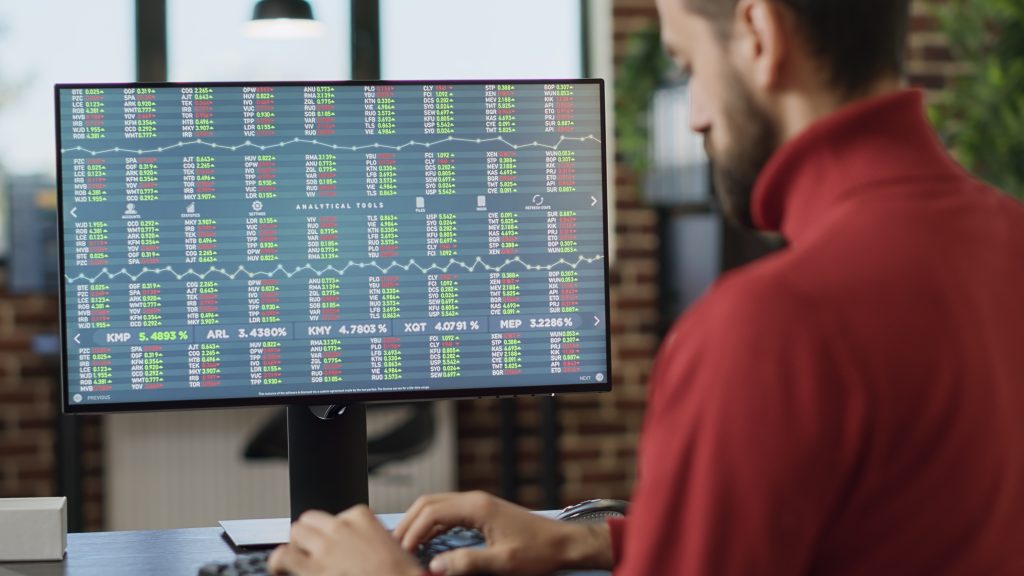Trading is one of the most popular ways to make money online in 2025. Whether it’s forex trading, stock trading, or crypto trading, millions of traders buy and sell financial assets every day. But what exactly is trading, and how does it work? This guide breaks down the essentials — from the basics to expert strategies.

What Is Trading?
Trading is the process of buying and selling financial instruments — such as stocks, currencies, cryptocurrencies, commodities, or indices — with the goal of making a profit.
Traders speculate on price movements:
- Buy (go long) when they expect prices to rise
- Sell (go short) when they expect prices to fall
Trading can take place on various platforms and markets, including stock exchanges, forex markets, and cryptocurrency exchanges.

How Does Trading Work?
Trading works by taking advantage of market fluctuations. Traders analyze charts, trends, and news to predict where prices will move next. When done correctly, trading can generate consistent profits. However, it also involves risk management, discipline, and strategy.
Here’s a simple breakdown of how trading works:
- Choose a market – Forex, crypto, stocks, or commodities.
- Open a trading account – With a regulated online broker.
- Fund your account – Many platforms let you start trading with as little as $100.
- Analyze the market – Use technical analysis or fundamental analysis.
- Place a trade – Buy or sell based on your analysis.
- Manage your risk – Set stop-loss and take-profit levels.
- Monitor and close the trade – Take profit or minimize losses.
Types of Trading

There are several trading styles and markets to choose from:
1. Forex Trading
Forex (foreign exchange) trading involves exchanging one currency for another. It’s the largest financial market in the world, with over $7 trillion traded daily. Traders use leverage to amplify profits — but it can also magnify losses.
2. Stock Trading
Stock trading means buying and selling company shares. Investors can profit from price changes and dividends. It’s ideal for those interested in companies and long-term growth.
3. Crypto Trading
Cryptocurrency trading focuses on digital assets like Bitcoin (BTC), Ethereum (ETH), and Solana (SOL). These markets are open 24/7 and highly volatile — perfect for short-term traders.
4. CFD and Futures Trading
CFDs (Contracts for Difference) and futures allow traders to speculate on price movements without owning the underlying asset. These are leveraged instruments, meaning you can control larger positions with less capital.
Subscribe to receive daily reviews about Brokers worldwide
Key Trading Strategies
To succeed in trading, you’ll need a clear plan. Here are a few popular strategies:
- Day Trading – Open and close trades within one day.
- Swing Trading – Hold trades for several days to capture short-term trends.
- Scalping – Make many small trades to profit from minor price changes.
- Position Trading – Long-term strategy based on fundamental analysis.
Benefits & Risks of Trading
Benefits of Trading
- Potential for high returns
- Flexible working hours (trade from anywhere)
- Access to global markets 24/7
- Leverage and margin trading options
- Educational resources for beginners
Risks of Trading
- Market volatility can cause rapid losses
- Leverage amplifies both profits and losses
- Emotional trading and lack of strategy lead to failure
Frequently Asked Questions (FAQ)
Yes, many brokers allow you to start trading with just $100. However, start small, use risk management, and focus on learning rather than earning at first. With forex micro-accounts or crypto exchanges, $100 is enough to begin.
Forex trading is legal in most countries, but regulations vary. Always check if your broker is licensed by financial authorities like the FCA (UK), CySEC (EU), or ASIC (Australia). Avoid unregulated platforms.
No experience is required to start, but education is essential. Use demo accounts, follow trading tutorials, and practice strategies before investing real money. Successful traders never stop learning.
The best times to trade forex are during market overlaps — when the London and New York sessions are both active (8 AM–12 PM EST). That’s when volatility and liquidity are highest.
Trading can be profitable, but it’s not a get-rich-quick scheme. It requires discipline, strategy, and emotional control. Many beginners lose money before becoming consistently profitable.
Conclusion

